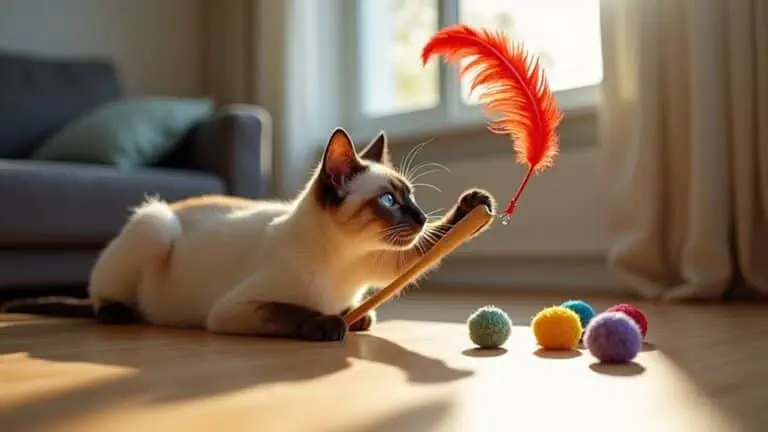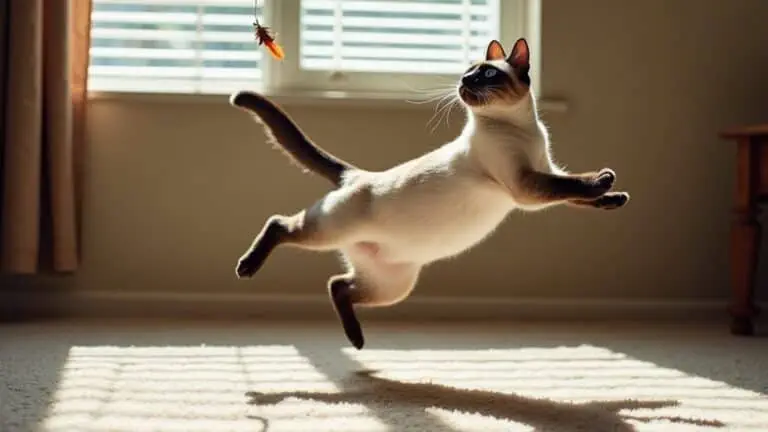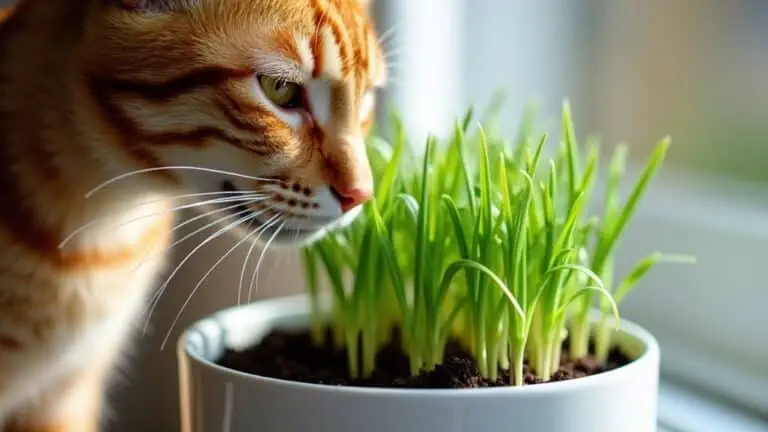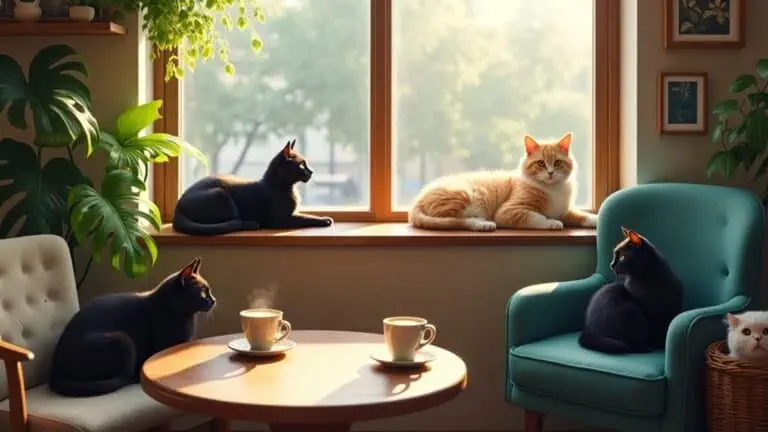The Best Fluffy Pancakes recipe you will fall in love with. Full of tips and tricks to help you make the best pancakes.

As a cat owner, one of my biggest concerns is keeping my feline friend safe from harmful houseplants. That’s why I’ve done extensive research to find 11 of the best indoor houseplants that are both visually appealing and completely safe for cats to be around.
In this section, I’ll be sharing information on each of these cat-friendly plants, including the elegant Kentia Palm, the easy-to-grow Spider Plant, and the stunningly unique String of Hearts. With these indoor plants, you can create a safe and beautiful environment for both you and your beloved furry friend.
Table of contents
Consider adding Kentia Palm, Parlour Palm, Maidenhair Fern, Boston Fern, Chinese Money Plant, Calathea, Dwarf Banana Plant, Watermelon Peperomia, Spider Plant, Cast Iron Plant or String of Hearts – all safe for felines.
Some common houseplants can harm your cat’s health, such as aloe vera, daffodils, lilies, and English ivy, among others. Familiarize yourself with the list of toxic plants and avoid bringing them into your home.
Kentia Palm
This indoor houseplant, also known as the “Howea forsteriana,” is one of the most popular palms due to its easy maintenance and elegant appearance. The Kentia Palm has feather-like fronds that grow from a slender trunk, making it visually attractive and a great addition to any room.
Not only is the Kentia Palm aesthetically pleasing, but it’s also safe for cats as it’s not toxic to them. This makes it an ideal choice for pet owners looking to add greenery to their homes while keeping their furry friends safe.
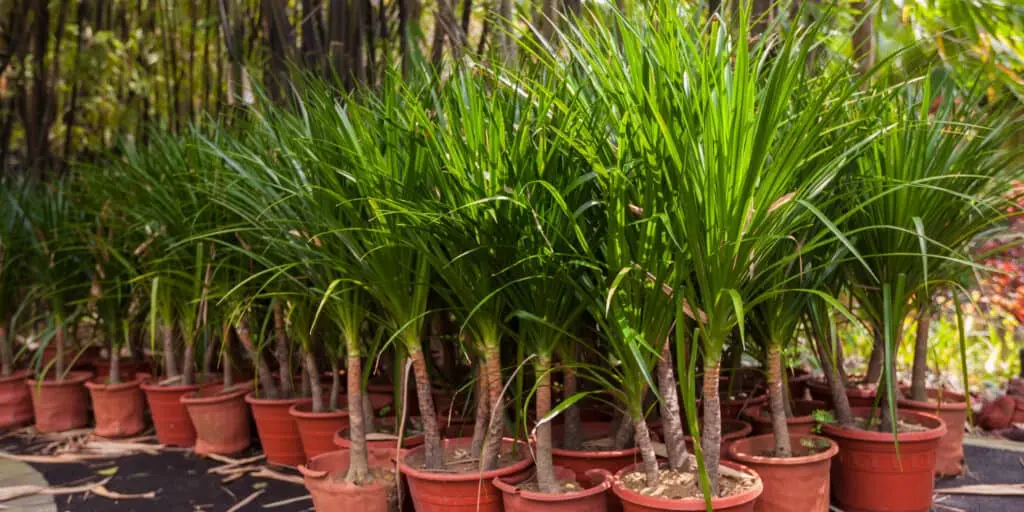
One unique detail about this plant is that it can tolerate low light conditions, making it adaptable for various parts of your home. Additionally, it’s a slow-growing plant, so you won’t have to worry about constantly pruning or repotting it.
To make sure your Kentia Palm thrives indoors, place it in indirect sunlight and water it when the top inch of soil feels dry. It’s also recommended to mist the leaves occasionally and fertilize every two weeks during the summer growing season. By following these suggestions, you can enjoy a healthy Kentia Palm in your home while keeping your cat safe.
Your cat may think the Parlour Palm is a jungle gym, but at least they won’t be tempted to nibble on it like other plants.
Parlour Palm
One of the top indoor plant choices that is safe for cats is the Parlour Palm. This plant is also known as the Neanthe Bella Palm or the Chamaedorea elegans, and it is a small palm tree that has a forgiving nature and low-light tolerance, making it ideal for indoor environments. Not only does its lush green foliage make for an attractive addition to any home decor, but this plant also helps purify the air by removing toxins like benzene and formaldehyde.
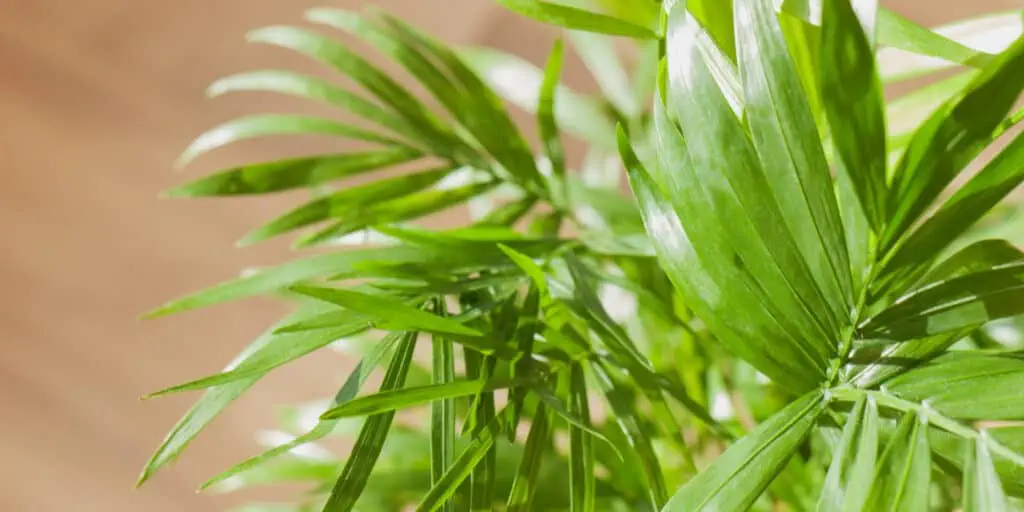
Parlour Palms are easy to care for and require minimal maintenance, but they do require consistent watering and high humidity levels. They thrive in indirect sunlight, making them ideal for shady places like bedrooms and living rooms. If you notice your palm’s leaves turning brown or crispy, this may be a sign that it needs more water or higher humidity levels.
One unique detail about Parlour Palms is that they are native to tropical regions in Southern Mexico, Guatemala, and Belize. They were first discovered in 1841 by an English botanist on an expedition to Central America. Since then, they have become popular houseplants around the world.
Overall, if you’re looking for a safe and visually appealing houseplant option for your feline friend, Parlour Palm should definitely be on your list of considerations. Its natural abilities to purify the air make it a great choice for any household looking to improve their indoor air quality.
“I never knew my cat had such a refined taste in ferns until we added the Maidenhair to our indoor jungle.”
Maidenhair Fern
This delicate houseplant, with its lacy foliage and light green colour, is known as the Maidenhair Fern. It’s popular indoors due to its appealing appearance, but it can be a challenge to grow and maintain without proper care.
Maidenhair ferns prefer bright but indirect light and moist soil. To keep the plant healthy, ensure that it remains in moist soil at all times and provide sufficient drainage as the roots can become waterlogged quickly. It also prefers higher humidity levels than most indoor plants, so place it on a tray of pebbles or mist the leaves often.
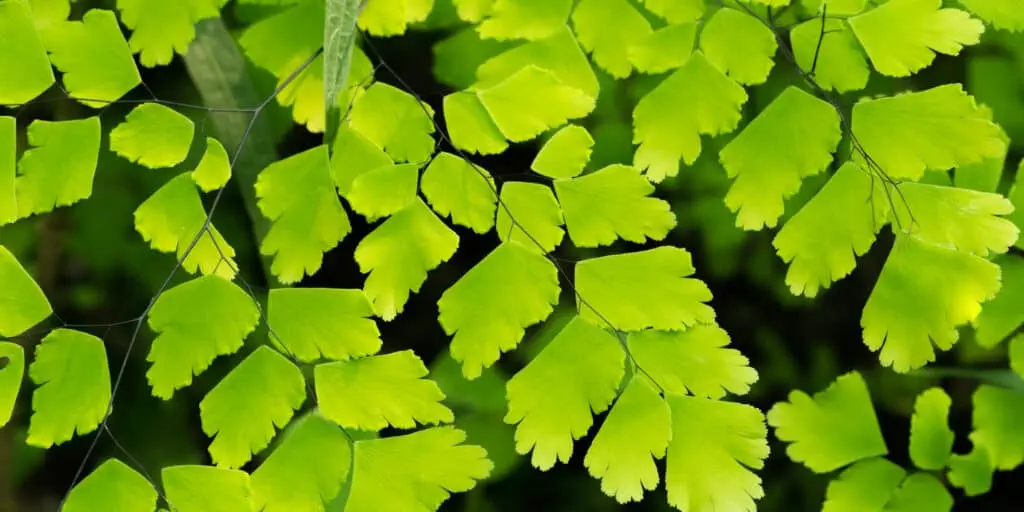
Notably, this plant is not toxic to cats but may have undesirable effects if ingested, such as an upset stomach. Ensure that your pets do not nibble on the leaves or escape tightly spaced windowsills.
If you’re looking for a beautiful and safe indoor plant for both you and your feline friend, The Maidenhead Fern is a great choice! Keep in mind that caring for this particular species can be challenging but also rewarding if done properly.
Give your cat a taste of the jungle with the Boston Fern, without risking a trip to the vet.
Boston Fern
The Boston fern is one of the top 11 indoor houseplants safe for cats. It is a popular choice for pet owners due to its non-toxicity and air-purifying qualities. This easy-to-care-for fern prefers indirect light and moist soil, making it an ideal plant for bathrooms or kitchens.
The Boston fern has unique fronds that can grow up to two feet long, providing a lush green addition to any household. It also has the ability to remove pollutants such as formaldehyde and xylene from the air, making it beneficial not only for pets but also for humans.
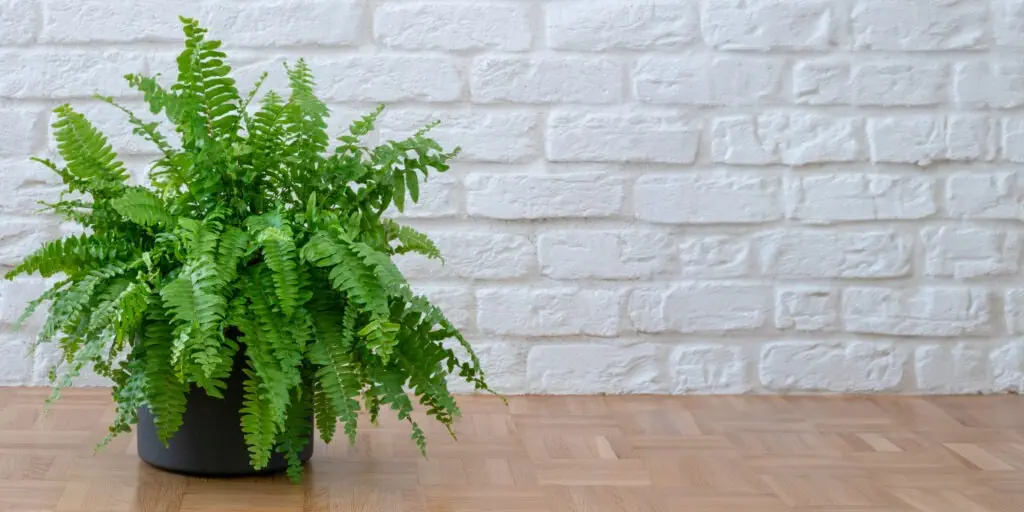
In addition, the Boston fern can work as a natural humidifier by releasing moisture into the air through its leaves. This makes it an excellent choice for homes with dry air or during winter months when indoor heating leads to dryness.
To ensure your cat’s safety around the Boston fern, it’s important to keep the plant out of reach and monitor your cat’s behavior around it. If you notice signs that your cat has eaten something they shouldn’t have, such as vomiting or diarrhea, contact your veterinarian immediately.
Don’t miss out on the benefits of having an indoor plant safe for cats like the Boston fern. Incorporate this beautiful and functional plant into your home today. Even your cat will want to invest in this Chinese Money Plant – just don’t let them get too greedy with the leaves.
Chinese Money Plant
A popular and safe indoor plant option for cat owners is the Chinese money plant. This succulent-like plant has round leaves that resemble coins, hence its name. It is easy to care for and thrives in bright, indirect light. The Chinese money plant is also known for its air-purifying properties, making it a great addition to any household.
Unique to the Chinese money plant is its ability to grow offspring or “pups” from the base of the mother plant. These pups can be propagated by separating them from the mother and repotting them in their own container. This makes the Chinese money plant a fun and low-cost way to expand your houseplant collection.
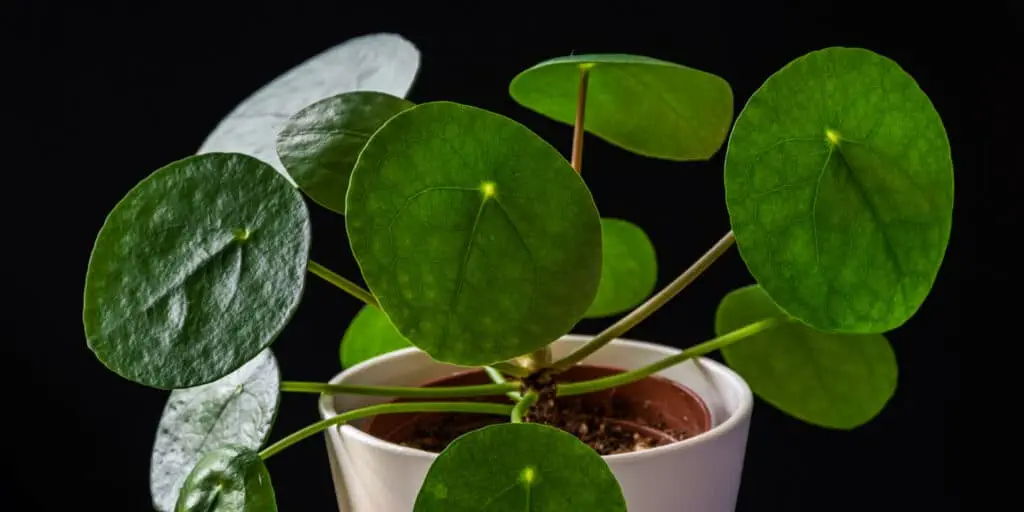
Many people also believe that the Chinese money plant brings good luck and prosperity due to its coin-shaped leaves, as well as its origins from Asia where it is seen as a symbol of fortune. While there may not be scientific evidence to support this belief, adding a touch of positivity and good energy never hurts.
One cat owner shared how her curious feline would frequently nibble on her Chinese money plant without any ill effects. This shows that not only is the Chinese money plant safe for cats but also durable enough to withstand some chewing from curious pets.
Calathea plants are safe for your furry feline friends, which means you can finally have some greenery that doesn’t double as a cat toy.
Calathea
This section covers safe indoor houseplants for cats, with a focus on Calathea (Sanderiana, orbifolia, zebrina, triostar). These plants are known for their vibrant foliage and air-purifying qualities that make them perfect additions to your cat-friendly home.
Calathea is non-toxic to cats and offers unique benefits like lowering stress levels and boosting mood. The plant does best in well-lit areas but avoid exposure to direct sunlight as it can burn the leaves. Water regularly and keep the soil moist but not waterlogged.
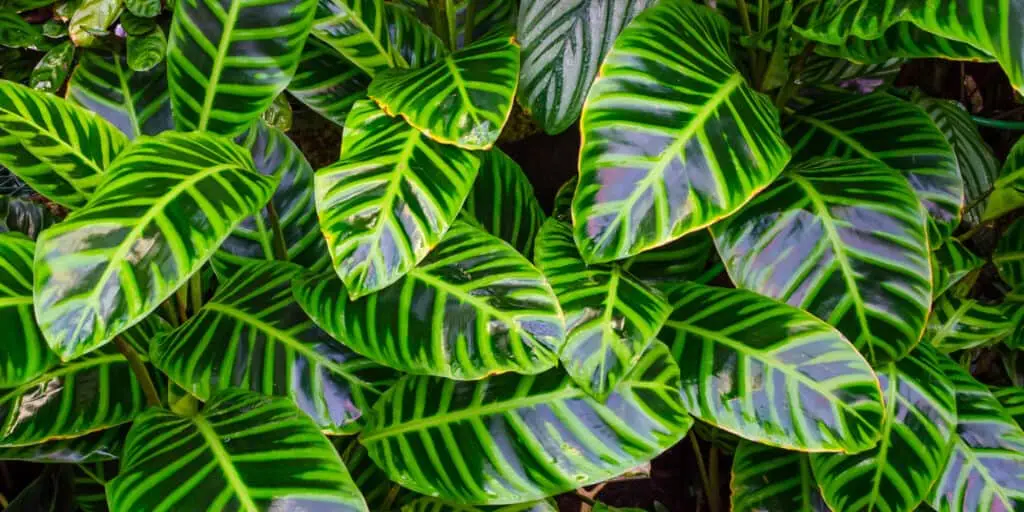
Calathea (Sanderiana, orbifolia, zebrina, triostar) have distinct leaf patterns with colors ranging from green to purple. It is worth noting that these plants are sensitive to environmental changes and require consistent humidity levels of approximately 50-60%. Calathea plants also exhibit what’s known as “prayer plant” behavior where their leaves fold up at night and open during the day.
If you’re looking for a safe yet striking option for your cat-friendly home, consider Calathea (Sanderiana, orbifolia, zebrina, triostar). As with any new plant introduction or change in environment for your feline companion, monitor them closely to ensure they do not show any signs of allergy or discomfort.
Calatheas have a long history of being used medicinally in South America for their healing properties and as part of many cultural ceremonies. They were traditionally used by indigenous people to treat skin conditions, wounds and also had ritualistic uses. Today they are mainly grown for ornamental purposes and appreciated by plant enthusiasts worldwide.
Your cat may not be able to climb trees, but with the Dwarf Banana Plant, they can at least pretend to be Tarzan.
Dwarf Banana Plant
This petite version of the banana plant is an excellent choice for cat owners. With its lush green leaves and fun size, the Dwarf Banana Plant is often used as a decoration in living rooms or bedrooms. In addition to looking fantastic, this plant helps purify the air by removing toxins from indoor environments.
It’s important to take note that while the Dwarf Banana Plant is safe for cats, some larger banana plants are toxic to felines if ingested. However, pet owners can rest assured that their furry friends can coexist safely with this particular banana plant.
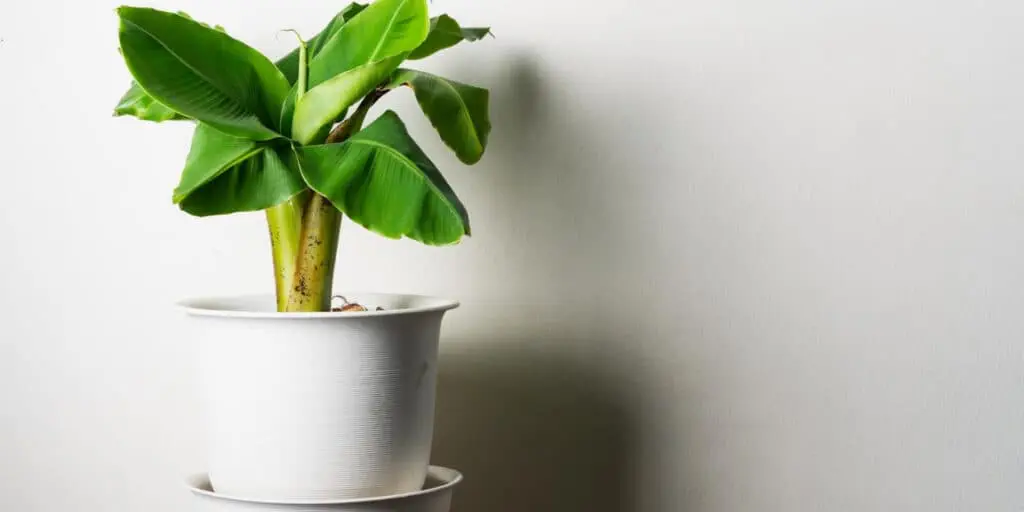
If you’re looking for something unique and exotic that won’t harm your pets, consider adding a Dwarf Banana Plant to your indoor garden. Its tropical vibe and compact size make it perfect for apartments or small spaces.
One cat owner shared how thrilled she was when she received a Dwarf Banana Plant as a gift from a friend. She noted that not only did her apartment look brighter, but her cat also seemed to enjoy having the new addition around. The plant added life and color to her space without posing any risks to her beloved feline friend.
Your cat will be drooling for more than just watermelon with this safe and stylish houseplant.
Watermelon Peperomia
This hardy foliage variety, known as Watermelon Peperomia, is a popular indoor houseplant that is safe for cats to ingest. Its unique oval-shaped leaves with vibrant green stripes resemble the fruit of a watermelon. Watermelon Peperomia requires minimal care and thrives in moderate to bright light conditions, making it a perfect addition to any cat-friendly home.
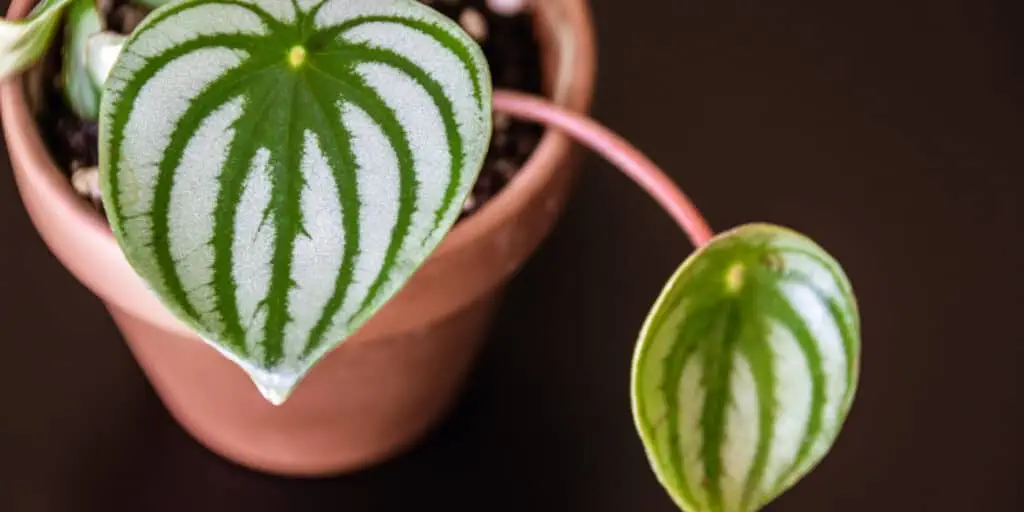
It’s worth noting that while Watermelon Peperomia is non-toxic to cats, some pets may still experience digestive discomfort if they eat large quantities of the plant. As with any plant, pet owners should monitor their cats for signs of overconsumption or other adverse reactions.
Interestingly, the leaves of Watermelon Peperomia contain small “windows” on the upper surface which allow sunlight to pass through and reach lower leaves. This adaptation allows the plant to thrive in low-light conditions often found indoors.
Spider Plant: Not just for scaring arachnophobes, but also a great indoor plant option for cat owners.
Spider Plant
Spider plant (Chlorophytum) is a safe indoor houseplant for cats. It is non-toxic and can be grown easily in most home environments. Chlorophytum has long, thin leaves that grow in clusters and small white flowers that bloom in the summer. The spider plant is known to purify the air by removing toxins like formaldehyde and xylene.
This plant is versatile as it can be grown indoors or outdoors, making it an excellent option for cat owners who want to have plants around their furry friends without putting them at risk. Additionally, the spider plant is easy to care for, requiring only bright but indirect sunlight and regular watering.
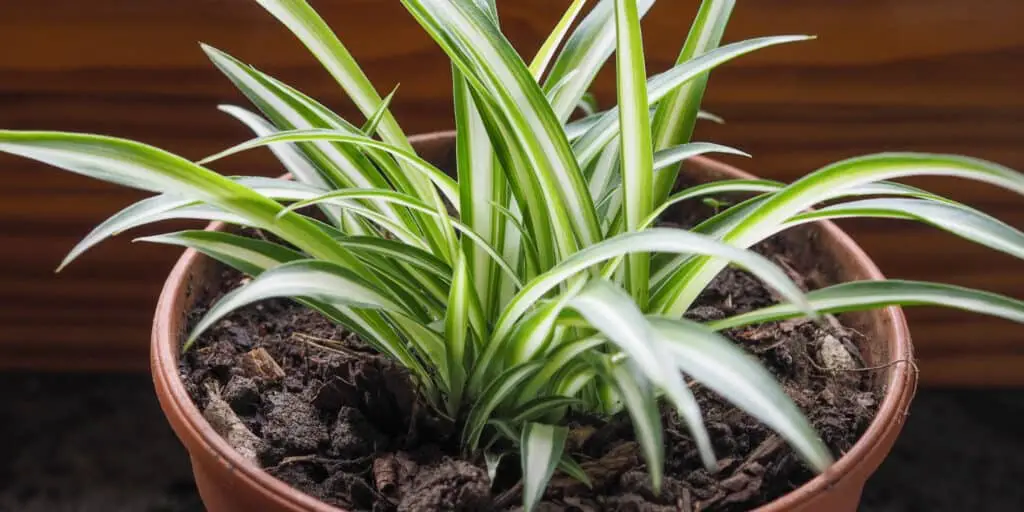
One unique characteristic of the spider plant compared to other indoor plants safe for cats is that it produces plantlets that hang from its long stems called “spider babies.” These babies can be propagated into new plants, making the spider plant an affordable way to add some greenery to your home while keeping your feline friend safe.
To ensure your cat’s safety around indoor plants, use hanging baskets or place them on high shelves where curious paws cannot reach them. Overall, incorporating safe indoor houseplants like Chlorophytum into your home decor can bring many benefits while keeping your cat healthy and happy.
Even your cat can’t kill this tough plant – Cast Iron Plant (Aspidistra).
Cast Iron Plant
One of the top indoor houseplants that are safe for cats is the cast iron plant (Aspidistra). This resilient, low-maintenance plant can handle a range of lighting conditions and does not require frequent watering. Its broad leaves also make it a great choice if you want to add some visual interest to your home without compromising your cat’s safety.
The cast iron plant (Aspidistra) is a wise investment for pet owners who may not have much time or energy to devote to houseplant care. It can thrive in low light conditions and only needs occasional watering, making it perfect for busy lifestyles. The plant’s thick stems and dark green, glossy leaves will bring some life to any room in your home, while also ensuring your feline friend stays healthy.
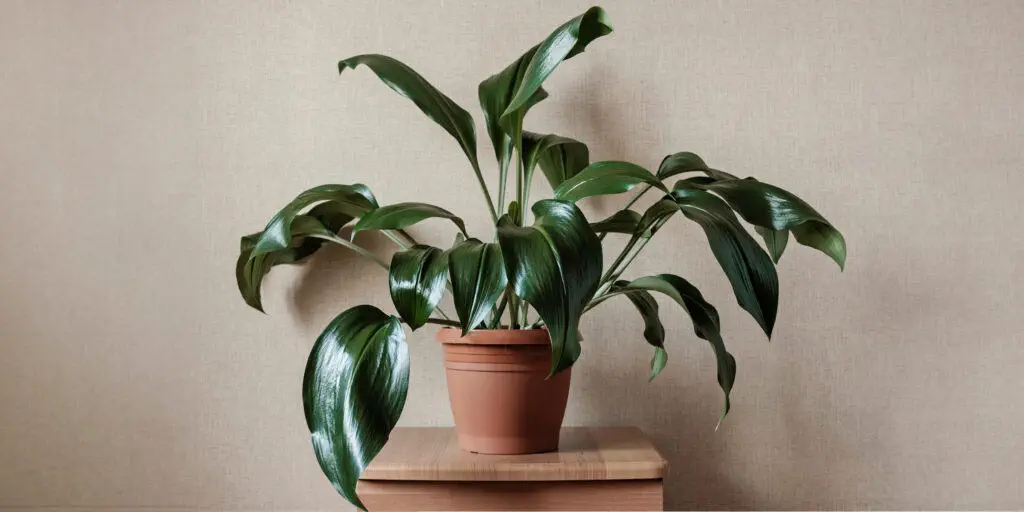
It’s worth noting that even the safest plants can pose risks if ingested by pets. If you suspect your cat has eaten something they shouldn’t have, watch out for symptoms such as vomiting, diarrhea, lethargy or loss of appetite. If these signs persist or worsen, seek veterinary care immediately.
A friend of mine once brought home a beautiful arrangement of flowers that included lilies – an unfortunate mistake given her cat lived with her at the time. Within hours of bringing them into her apartment, her cat had become dangerously ill due to lily poisoning which unfortunately led to seizure before they managed to get medical attention. This event prompted my friend to research safe houseplants for pets.
Who needs Valentine’s Day when you can have a String of Hearts (Ceropegia Woodii) that loves your cat as much as you do?
String of Hearts
One of the indoor houseplants that are safe for cats is the String of Hearts, scientifically known as ceropegia woodii. This plant is uniquely known for its delicate and twining vines with small heart-shaped leaves that create a beautiful cascading effect. This perennial succulent does well in dry environments and filtered sunlight, making it easy to take care of.
String of Hearts has unique features such as producing flowers that look like an upside-down white or purple lantern, giving it an exceptional ornamental value. It also plays a significant role in air purification, removing toxins from the room, thus providing a healthy environment for both the cat and their owners.
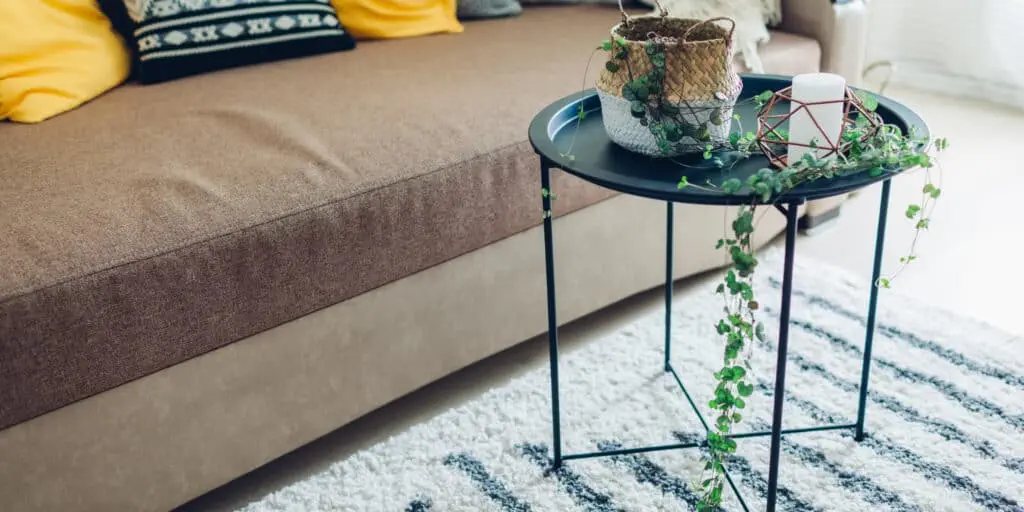
Furthermore, String of Hearts symbolizes love and affection between people and pets, making it popular among pet owners to give to their cats as a symbol of appreciation. Despite this plant being non-toxic, precautionary measures should always be taken around our feline friends to avoid any accidental ingestion or damage caused by playing with the plant.
In history, Ceropegia woodii was discovered in 1881 by Gustav Schwantes in Tanzania and named after an Austrian botanist Kaspar Maria von Sternberg’s family name. It initially gained popularity in the Victorian era when people appreciated trailing plants as they were seen as attractive to enhance interior decor aspects such as enhancing window displays with hanging baskets. Over time, this unusual climbing plant has gained recognition by indoor garden enthusiasts due to its extraordinary beauty that adds elegance and charm to any home’s living space.
Keep your cat alive and thriving, not just surviving, by avoiding these toxic plants like they’re the plague.
Risks of Toxic Houseplants to Cats
As a cat owner, it’s important to ensure the safety and well-being of your furry friend by making your home a hazard-free zone. One of the biggest risks for indoor cats is the potential danger of toxic houseplants. In this part of the article, we’ll discuss the risks associated with having certain plants around cats. You’ll learn more about plants that you should absolutely avoid if you have a feline companion. Additionally, we’ll look at the telltale signs that your cat may have ingested something that they shouldn’t have, so you can stay alert and keep your pet healthy.
According to the American Society for the Prevention of Cruelty to Animals (ASPCA), as much as 80% of common household plants can potentially be toxic to cats if ingested.
Plants to Absolutely Avoid
Some Plants are poisonous to your furball even if they chew or ingest them accidentally. Here is a list of some ‘no-no’ houseplants that you must avoid keeping if you have cats at home.
- Lilies
- Dieffenbachia
- Pothos
- Rubber plant
- Aloe Vera
- Philodendron
These indoor plants are some of the most common and deadly poisonous plants for our feline friends. If your cat has ingested any part of the plant, its symptoms could range from typical stomach ailments like vomiting, diarrhea, lethargy, and other alarming symptoms like difficulty in breathing. Even small-sized ingestibles could lead to significant deterioration in their health.
Make sure that safety comes first when it comes to indoor plants safe for cats, and stay on the positive side in selecting the right comestible posy for your pet cat. Intrinsic to this aim is owners knowing what is good and what is not good for their animal’s well-being.
If you want to keep your feline friend away from harm’s way, it’s critical that you stick with indoor houseplants safe for cats. Ensure that they don’t suffer from unsafe flora consumption by offering them only those listed as best by experts on indoor plans safe for cats while selecting some greenery to spruce up their environment indoors.
Looks like your cat’s feeling adventurous again, time to keep an eye out for these tell-tale signs of trouble.
Signs Your Cat Ate Something They Shouldn’t Have
When cats ingest toxic houseplants, it can cause severe health problems. It’s crucial to know the signs your cat ate something they shouldn’t have to act quickly and get them to the vet.
- Vomiting or Diarrhea: Consistent vomiting or diarrhea is a clear indicator that something might be wrong with your cat.
- Loss of appetite: If your cat isn’t interested in eating their food, it could indicate that they’ve eaten something they shouldn’t have.
- Lethargy: When animals aren’t feeling well, they often become lethargic and lose interest in their surroundings or even moving around.
- Behavioral Changes: Cats who are feeling unwell may hide more often than normal or avoid activities such as playing or cuddling with their owners.
- Difficulty Breathing: Ingesting some types of houseplants can cause difficulty breathing for cats. If you notice any respiratory problems, seek immediate medical help for your cat.
It’s worth noting that not all cats will show these symptoms in the same way and severity levels can vary. Therefore, if you suspect your cat has been poisoned, take them to the vet immediately.
Avoiding toxic houseplants is the best way to prevent this issue from occurring; however, accidents still happen.
One story which serves as an example is when a feline named Puddles ingested Easter lilies while his owner was away on vacation. Puddles’ owner discovered he had chewed through the flowers’ leaves when she returned home a few days later. She took him straight to emergency care where he received treatment and ultimately made a full recovery.
Five Facts About Indoor Plants Safe for Cats:
- ✅ There are many indoor plants that are safe for cats, including the Kentia Palm, Parlour Palm, and Maidenhair Fern.
- ✅ Lilies are one of the most toxic plants for cats, and can cause irreparable kidney damage or failure within just a few days of ingestion.
- ✅ Signs that your cat may have eaten something toxic include vomiting, diarrhea, drooling, confusion, loss of appetite, thirst, fits or seizures, and skin or eye irritation.
- ✅ Cat-safe indoor plants not only add greenery to your home but can also have air-purifying qualities.
- ✅ The spider plant, while technically safe for cats, contains leaves that are a hallucinogenic for our feline friends and may make them extra curious.
FAQs about Indoor Plans Safe For Cats
What are cat-safe houseplants?
Cat-safe houseplants are indoor plants that are not harmful to cats even if ingested. Some examples of cat-safe houseplants are Kentia Palm, Parlour Palm, Maidenhair Fern, Boston Fern, Chinese Money Plant, Calatheas, Dwarf Banana Plant, Watermelon Peperomia, Spider Plant, Cast Iron Plant, String of Hearts, and Aspidistra.
What are the risks of toxic houseplants to cats?
There are many houseplants that are toxic to cats. The symptoms of toxicity can range from mild such as irritations on the skin, eyes, or gums, to severe such as kidney damage or failure, confusion, seizures, and even death.
What are plants to avoid when you have a cat?
Cats should not be exposed to lilies as every part of the plant is toxic for them. Other plants to avoid are carnivorous plants, Polka Dot Plant, Flamingo Plant, Pineapple Plant, and all other plants that are known to be toxic to pets.
What are the signs that a cat has eaten something it shouldn’t have?
If your cat has eaten something it shouldn’t have, it may experience symptoms such as vomiting, diarrhea, excessive drooling, confusion, loss of appetite, extra thirst, seizures, or irritations on the skin, eyes, or gums.
What care requirements do cat-friendly houseplants need?
Cat-friendly houseplants may have different care requirements depending on their species. Generally, they need regular watering, moderate amounts of light, some humidity, and a well-draining soil mix. Some might require frequent misting, fertilizing, and pruning.
What are some popular choices for cat-friendly houseplants?
Some popular choices for cat-friendly indoor plants are Kentia Palm, Chinese Money Plant, Calatheas, Watermelon Peperomia, Spider Plant, Pilea, Ponytail palms, and Areca Palm. These indoor plants not only add beauty to your home decor but also help purify the air.

